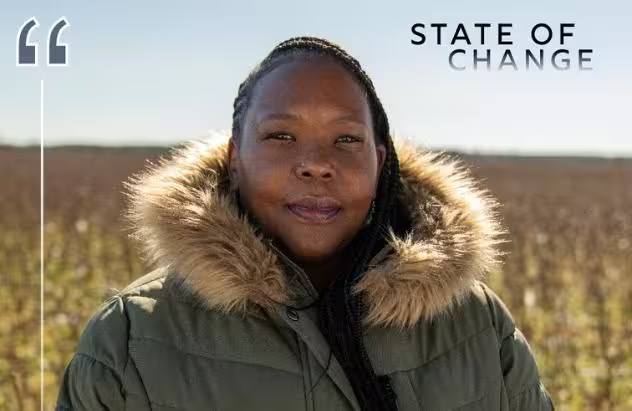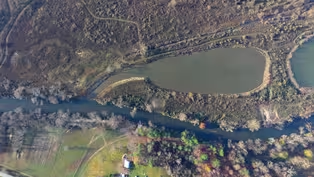
The Coharie Indian Tribe: Returning to the River
Clip: Special | 8m 42sVideo has Closed Captions
The Coharie Indian Tribe's restoration of their namesake river prompts a cultural awakening.
Storms and beaver overpopulation have blocked the Great Coharie River, making it unnavigable. But the Coharie Indian Tribe is restoring their namesake river and introducing it to the next generation, who grew up without it. The restoration project is reconnecting them to their heritage and preparing them to steward the river as climate change reshapes the surrounding landscape.
Problems playing video? | Closed Captioning Feedback
Problems playing video? | Closed Captioning Feedback
State of Change is a local public television program presented by PBS NC
State of Change is part of the Pulitzer Center’s Connected Coastlines reporting initiative. For more information, go to https://pulitzercenter.org/connected-coastlines.

The Coharie Indian Tribe: Returning to the River
Clip: Special | 8m 42sVideo has Closed Captions
Storms and beaver overpopulation have blocked the Great Coharie River, making it unnavigable. But the Coharie Indian Tribe is restoring their namesake river and introducing it to the next generation, who grew up without it. The restoration project is reconnecting them to their heritage and preparing them to steward the river as climate change reshapes the surrounding landscape.
Problems playing video? | Closed Captioning Feedback
How to Watch State of Change
State of Change is available to stream on pbs.org and the free PBS App, available on iPhone, Apple TV, Android TV, Android smartphones, Amazon Fire TV, Amazon Fire Tablet, Roku, Samsung Smart TV, and Vizio.

Explore More from State of Change
Hear from North Carolinians about climate change effects & innovative solutions across the state.[water sloshing] - I love this quote, I can't remember where I got it from, but, rivers never go in reverse.
You can apply that to your life.
Life is beautiful, so many things to look forward to, and I think that can kinda tie into the tight and windy path our river is, the braided channel.
That's how life is.
[soft music] - The Great Coharie River is a braided stream in its headwaters, and that means that the stream has multiple channels.
If you look at it from overhead, they sort of intertwine and weave in and out of one another.
That is a common characteristic of streams that flow through sandy areas like Sampson County.
Here in the Southeast, climate change is making the water cycle more extreme.
In Eastern North Carolina, that is no exception.
Rivers like the Great Coharie are also subject to these extreme flows, and we've seen this in recent years through floods that have come with hurricanes.
They've also had very intense droughts in the region, and those swings between high and low create all kinds of challenges for people and for the river itself.
[soft music] - The Great Coharie River Initiative started with a simple premise of just gaining access to the Great Coharie River here in Coharie land.
The land down south of here, on the other side of Clinton, the water systems down there, they're open, the river flows free, but up here was clogged with debris.
- The storms had downed trees, the overpopulation of beavers had dammed up the mud, the water wasn't flowing, it was backing up on agricultural soil.
- From the perspective of Coharie people, a healthy river is one that has constant interaction with people, through paddling, through fishing, through swimming, and just being closed to the river.
And because the river was closed off to them for so many years, it had devolved into an unhealthy state.
And so one of the early aims of the Great Coharie River Initiative was to clear a path through the river channels so that people could once again paddle this beautiful blackwater stream.
[light music] - The crew that we used or talked into helping us was our drum team.
We just asked 'em, "Look, can y'all come help us Saturday clean out a section of the river?
And it's gonna be dirty, and nasty, but we'll have a good time.
We could feed you, but that's all we could offer you."
The first three or four Saturdays that we worked, we cleaned out probably about a mile of river.
Out of those eight young men, the first day we started, there was only one that had a full-time job.
And what I noticed about that same group the second year when they came back, there was only one person that didn't have a job.
So we saw something that came alive there that made a difference in a group of young men in our community.
- I'm not so sure that we've helped that river as much as it has helped us.
This awakening that's taken place, it's come into our community.
So many more people participating, so many more people being responsible.
We know the importance, and that's gonna be passed down from generation to generation to generation.
- The greatest change that I've seen has been in our young folks.
The drum team has gotten bigger.
We have culture classes here now.
We have younger folks that have grown up through this Great Coharie River Initiative era who are participants in those classes.
[soft percussion music] ♪ Oh, oh ♪ - [Greg] This canoe here that we have in our museum is 600 years old, and as we have turned to our responsibility of debris removal in the rivers of Samson County, it was found over in South River.
So in my mind, it's like we're being responsible, now we're being the people that we should be, and maybe it's proud of us, so it decided to show its face and come back to this cultural revival.
[singers singing in native language] Kullen is one of our best examples that got away, away from home, but once he was introduced back into that, something spoke to him that changed him forever.
Now you can't get him to stop.
Something that was lying dormant inside of him, that river tapped into it and it sprang up.
[gentle music] - I'ma go way back.
I was born in 1993.
Growing up, I remember hearing stories from my grandpa, my dad, about fishing down in our water, the Dano Hole, which is actually Mr. Phillip Bell's dad's, my great-uncle, Dano Bell, and it's where a lot of food source came from for our people.
The first time I was introduced to the waterway was around 2015, 2016, and I was like, this is insane, this natural resource in my backyard that I wasn't able to enjoy as a kid.
Then when I got more involved and we created the Coharie River Tours.
It just helped me slow down.
I was living in Wilmington, North Carolina, and that's a fast-paced life.
Just helped me slow down and really, when I'm out here on the river, think about important and what I want in life, and thinking of legacy and what you can do for your community.
I wasn't very involved in the culture growing up.
Once I got involved with the river, I remember I went to my first drum class.
Just remember that first time drumming with all, you know, mostly family members, that feeling I got from it.
I've never been able to put a finger to it.
It was just a good feeling.
[soft music] - [Ryan] Coharie, and Lumbee, and many other Indigenous peoples in the Southeast especially share names with rivers.
That is how our people identify.
Our rivers have a very strong spiritual and historical connection that involves their role in protecting us during early waves of colonization.
- When I go down that river, I can imagine my ancestors looking for a place of belonging, a place that was safe that they could raise their families.
I can feel people doing whatever they got to do to survive.
But the beautiful thing is that I can feel the satisfaction of when they came to the Coharie River.
Here's where we stopped running.
So here it is 2025, and we're still on the banks of the Coharie River, it bears our name, and we love it and we're gonna take care of it.
- Indigenous peoples are observers of their environment, and they have been since time immemorial.
They are scientists, technicians, philosophers, and they carry this deep knowledge.
It's not always recognized in the ways that we recognize it in academic spaces, but that doesn't make it any less valuable.
The story of the Great Coharie River Initiative is important because it shows how Indigenous peoples can not only take the stewardship of the environment into their own hands, but when they do, amazing things can happen.
You can have healthy ecosystems, you can have people who are learning what it means to be in close relationship with water.
- It doesn't have the same uses as it did to our ancestors, but it's still important to keep it maintained.
And I have tons of ideas on more of like, your 10 to 15 year plans on what this place could look like with proper care.
[soft music continues]
Battleship North Carolina: Living with the Tide
Video has Closed Captions
Clip: Special | 7m 50s | Tidal flooding skyrocketed at Battleship North Carolina. Natural systems may be the key to survival. (7m 50s)
The French Broad River: Fixing the Floodplains
Video has Closed Captions
Clip: Special | 8m 50s | Restored floodplains absorb and hold water, building resilience to climate change in Western NC. (8m 50s)
Preview | State of Change: Living with Water
Video has Closed Captions
Preview: Special | 1m | How communities are returning waterways to a natural state to address the impacts of climate change. (1m)
Providing Support for PBS.org
Learn Moreabout PBS online sponsorshipSupport for PBS provided by:
State of Change is a local public television program presented by PBS NC
State of Change is part of the Pulitzer Center’s Connected Coastlines reporting initiative. For more information, go to https://pulitzercenter.org/connected-coastlines.













